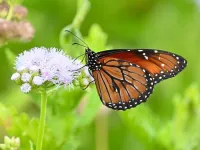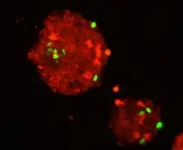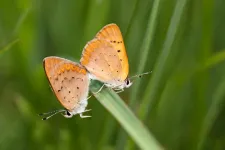(Press-News.org) BINGHAMTON, N.Y. -- Butterflies are beloved creatures that inspire art and play an important ecological role, but you might have noticed less of them brightening your day in recent years. According to new research featuring faculty at Binghamton University, State University of New York, these cherished insects are disappearing at an alarming rate.
A new study published in Science examines butterfly data in the United States, and the results are troubling. Looking across 76,000 surveys, the study revealed that butterfly abundance fell by 22% between 2000 and 2020. To put it starkly: for every five butterflies in the U.S. at the turn of the century, there were only four remaining in 2020.
“This was the most comprehensive analysis of butterflies in the US and at such a big spatial scale,” said Eliza Grames, an assistant professor of biological sciences at Binghamton University and co-author of the paper.
Butterflies are the most extensively monitored insect group in the United States, but most monitoring efforts have consisted of volunteer-based and expert science monitoring programs that are limited in geography and have focused on individual species.
This new study funded by the U.S. Geological Survey – uses all available monitoring data – 35 programs with records of over 12.6 million butterflies – to provide a clear picture of the state of butterfly species across the continental United States.
The study takes into account the variations in collection protocol and regions to produce comparable results for hundreds of species. Using data integration approaches, the team examined how butterfly abundances changed regionally and individually for the 342 species with enough data.
“Abundance” refers to the total number of individuals of a butterfly species within a given area. During the two-decade period examined, 33% of butterfly species showed significantly declining trends in abundance. Many showed extreme declines in abundance — 107 species declined by more than 50%.
Grames’ role in this nationwide study was to generate range maps for all butterfly species that fed into the analyses. This allowed the team to check whether observations of species were good identifications and should go into the model or if they needed to be checked for data quality cleaning purposes. The team could also see where each of these species could be found within the U.S. and examine spatial patterns.
“We didn't have maps for where many of the butterflies were,” said Grames. “How do we know which records are good? A bunch of them come from iNaturalist, a citizen science platform where anybody can upload pictures of species. But sometimes people go to a butterfly house and start recording all of these tropical species in, say, Colorado, which throws off the data.”
Part of those conservation efforts includes involving undergraduate students in assessments to gather data and determine how at risk a species might be. In Grames’ Conservation Biology class, students are currently working on IUCN assessments for western skippers, including one of the most declining butterfly species, the Julia’s skipper.
"Participating in this assessment has allowed me to apply what I've learned in class to real-world scenarios," said Clara Zook, a Binghamton University student working on the assessment for Julia's skipper with classmate Kieran Buchholz.
"It's empowering to know that our research could play a role in preserving this species," Buchholz said.
In addition to being beautiful and inspiring art, said Grames, butterflies also play a vital role in pollination, helping to pollinate food and flowers and contributing to the health of ecosystems around the world. This study could help drive important conservation efforts, such as prioritizing species for the International Union for Conservation of Nature (IUCN) Red List of Threatened Species and/or Endangered Species Act protection.
“We have much better data to go and say, ‘You know, we should really consider these for federal protection.’ So we can go in, conserve their habitat and – hopefully – they can rebound,” said Grames.
Collin Edwards, the study’s lead author, echoed those sentiments. “For those who were not already aware of insect declines, this should be a wake-up call,” Edwards said. “We urgently need both local- and national-scale conservation efforts to support butterflies and other insects. We have never had as clear and compelling a picture of butterfly declines as we do now.”
A second project, part of the same USGS group, is looking at the drivers of butterfly loss. A study in the Midwest has pointed to pesticides as a major driver, but there are different drivers across different regions of the U.S. For example, in the Southwest, there are concerns about drought, whereas in the Northeast, it’s more about climate.
Grames said that highlighting what’s happening with butterflies can help to provide a clearer picture of insect population decline overall.
“Insects are declining at rates of about 1-2% per year, which has come out across several studies,” she said. “This was another study finding a super similar rate of decline, which really adds evidence to the growing picture of insect declines globally.”
END
20% of butterflies in the U.S. have disappeared since 2000
Largest-ever analysis raises the possibility of a country without butterflies
2025-03-06
ELSE PRESS RELEASES FROM THIS DATE:
Bacterial ‘jumping genes’ can target and control chromosome ends
2025-03-06
ITHACA, N.Y. -- Transposons, or “jumping genes” – DNA segments that can move from one part of the genome to another – are key to bacterial evolution and the development of antibiotic resistance.
Cornell University researchers have discovered a new mechanism these genes use to survive and propagate in bacteria with linear DNA, with applications in biotechnology and drug development.
In a paper under embargo in Science until 2pm ET on March 6, 2025, researchers show that transposons can target and insert themselves at the ends ...
Scientists identify genes that make humans and Labradors more likely to become obese
2025-03-06
Researchers studying British Labrador retrievers have identified multiple genes associated with canine obesity and shown that these genes are also associated with obesity in humans.
The dog gene found to be most strongly associated with obesity in Labradors is called DENND1B. Humans also carry the
DENND1B gene, and the researchers found that this gene is also linked with obesity in people.
DENND1B was found to directly affect a brain pathway responsible for regulating the energy balance in the body, called the leptin melanocortin pathway.
An additional four genes associated with canine obesity, ...
Early-life gut microbes may protect against diabetes, research in mice suggests
2025-03-06
The microbiome shapes development of insulin-producing cells in infancy, leading to long-term changes in metabolism and diabetes risk, new research in mice has found.
The results could ultimately help doctors reduce the risk of type 1 diabetes—or potentially even restore lost metabolic function in adulthood—by providing specific gut microbes that help the pancreas grow and heal.
The findings are published in Science.
The critical window
Mice that are exposed to broad-spectrum antibiotics in early life have worse metabolic health in the long term, the researchers found. If the mice received antibiotics during a 10-day window shortly after birth, they developed ...
Study raises the possibility of a country without butterflies
2025-03-06
Butterflies are disappearing in the United States. All kinds of them. With a speed scientists call alarming, and they are sounding an alarm.
A sweeping new study published in Science for the first time tallies butterfly data from more than 76,000 surveys across the continental United States. The results: between 2000 and 2020, total butterfly abundance fell by 22% across the 554 species counted. That means that for every five individual butterflies within the contiguous U.S. in the year 2000, there were only four in 2020.
“Action must be taken,” ...
Study reveals obesity gene in dogs that is relevant to human obesity studies
2025-03-06
Dogs are a compelling model of human obesity, in part because they develop obesity due to similar environmental influences as people. In a genome-wide association study (GWAS) of Labrador retrievers, researchers have identified an obesity-related gene – DENND1B – that may also influence obesity in humans. These findings highlight the value of using non-traditional animal models to study complex diseases and highlight the gene’s potential as a target for future obesity research across species. Obesity is a ...
A rapid decline in US butterfly populations
2025-03-06
Butterfly populations across the United States are in alarming decline, according to a new study, with total abundance falling by 22% in just 20 years. Such widespread and worrisome losses portend broader environmental threats and emphasize the urgent need for conservation action. “Our national-scale findings paint the most complete – and concerning – picture of the status of butterflies across the country in the early 21st century,” write the authors. The decline of biodiversity has been extensively documented worldwide. Among these losses, the decline of insects is particularly ...
Indigenous farming practices have shaped manioc’s genetic diversity for millennia
2025-03-06
A new genomic study reveals how Indigenous traditional farming practices have shaped the evolution of manioc – one of the world’s most important staple crops – for the better. The domestication of plants and the rise of agriculture were transformative events in human history. Today, a few staple crops provide most human calories, including manioc (cassava or yuca), a vital root crop that sustains nearly a billion people across the tropics. Although it ranks as the world’s seventh most significant crop, manioc is primarily cultivated on small farms. The plant’s ...
Controlling electrons in molecules at ultrafast timescales
2025-03-06
Scientists at YOKOHAMA National University, in collaboration with RIKEN and other institutions in Japan and Korea, have made an important discovery about how electrons move and behave in molecules. This discovery could potentially lead to advances in electronics, energy transfer, and chemical reactions. Published in the Journal, Science, their study reveals a new way to control the distribution of electrons in molecules using very fast phase-controlled pulses of light in the terahertz range.
Atoms and molecules contain negatively charged electrons that usually stay in specific energy levels, like layers, ...
Tropical forests in the Americas are struggling to keep pace with climate change
2025-03-06
Embargoed until 14:00 US Eastern Time, Thursday 6 March 2025
Tropical forests in the Americas are struggling to keep pace with climate change
Tropical rainforests play a vital role in global climate regulation and biodiversity conservation. However, a major new study published in Science reveals that forests across the Americas are not adapting quickly enough to keep pace with climate change, raising concerns about their long-term resilience.
The research, led by Dr. Jesús Aguirre-Gutiérrez from the University of Oxford’s Environmental Change Institute (ECI), involved over 100 scientists ...
Brain mapping unlocks key Alzheimer’s insights
2025-03-06
Researchers from The University of Texas at Arlington and the University of California–San Francisco have used a new brain-mapping technique to identify memory-related brain cells vulnerable to protein buildup, a key factor in the development of Alzheimer’s disease, an incurable, progressive brain disorder that slowly destroys memory and thinking skills.
In Texas, nearly half a million people live with Alzheimer’s disease, a form of dementia that costs the state approximately $24 billion in caregiver time, according to the Texas Department of State Health Services. Texas ranks fourth in the nation for Alzheimer’s cases ...
LAST 30 PRESS RELEASES:
New modeling approach sheds light on rare gut disease
Study documents potentially hazardous flame retardants in firefighter gear
Can certain bacteria regulate aging of the immune system and its related alterations?
AI model helps diagnose often undetected heart disease from simple EKG
There are fewer online trolls than people think
Cell membrane fluctuations produce electricity
Jeonbuk National University study shows positive parenting can protect adolescents against self-harm
Surface-engineered ZnO nanocrystals to tackle perfluoroalkyl substance contamination
This new understanding of T cell receptors may improve cancer immunotherapies
A new fossil face sheds light on early migrations of ancient human ancestor
A new immunotherapy approach could work for many types of cancer
A new way to diagnose deadly lung infections and save lives
40 percent of MRI signals do not correspond to actual brain activity
How brain-inspired algorithms could drive down AI energy costs
Gum disease may be linked to plaque buildup in arteries, higher risk of major CVD events
Contrails are a major driver of aviation’s climate impact
Structure of dopamine-releasing neurons relates to the type of circuits they form for smell-processing
Reducing social isolation protects the brain in later life
Keeping the heart healthy increases longevity even after cancer
Young adults commonly mix cannabis with nicotine and tobacco
Comprehensive review illuminates tau protein's dual nature in brain health, disease, and emerging psychiatric connections
Book prepares K-12 leaders for the next public health crisis
Storms in the Southern Ocean mitigates global warming
Seals on the move: Research reveals key data for offshore development and international ecology
Sports injuries sustained during your period might be more severe
World's first successful 2 Tbit/s free-space optical communication using small optical terminals mountable on satellites and HAPS
Can intimate relationships affect your heart? New study says ‘yes’
Scalable and healable gradient textiles for multi‑scenario radiative cooling via bicomponent blow spinning
Research shows informed traders never let a good climate crisis go to waste
Intelligent XGBoost framework enhances asphalt pavement skid resistance assessment
[Press-News.org] 20% of butterflies in the U.S. have disappeared since 2000Largest-ever analysis raises the possibility of a country without butterflies







